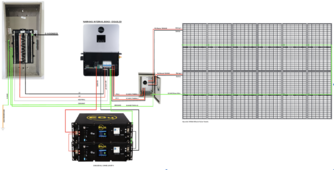HighCountry
New Member
Thanks!@HighCountry
Created four drawings showing your potential configurations based upon using buss bars or no buss bars as well as 2 batteries versus 3 or more batteries.
When using two EG4-LL-S batteries with the 6000XP, the capacity of the two EG4-LL-S batteries becomes fully utilized under peak conditions. So… when you get a handle on your specific loading of 6000XP, you can determine if there is any urgency of obtaining a 3rd battery.
These wires sizes are based off the NEC 2020 Table 310.17 (Per EG4-LL-S page 13 manual).
So back to the two-battery configuration. After looking at the battery specifications, it appears the two EG4-LL-S batteries may be able to support the 6000XP under peak surge conditions of 12,000W @268.8 amps for 3.5sec. In practice, I have not verified this surge condition. I suspect it based upon the BMS reaction to the surge versus the battery cells.
This is why if there is a chance the two-battery configuration can deliver the surge demand. Then the recommended 4 AWG wire would additionally be less resistive in the effort to support the surge over the 6AWG wire delivered with the battery.
If however, the two EG4-LL-S batteries cannot deliver the 6000XP 268.8 amps surge then your system would need 3 batteries to support the 6000XP surge requirements and now the 6AWG wire becomes the recommend wire size in a buss bar configuration (per NEC2020 Table 310.17).
The calculations in these drawings can be found in my previous post#48.
Hope this helps.
Drawings:
View attachment 202681
EG4 LL-S manual reads at page 14: "Attach a grounding wire from the rack/cabinet to an equipment grounding conductor, then terminate the EGC at a grounding electrode."
Does the wiring diagram below comport to that standard by grounding batteries (or rack) directly to PE ground on EG4 6000XP?

Last edited:


